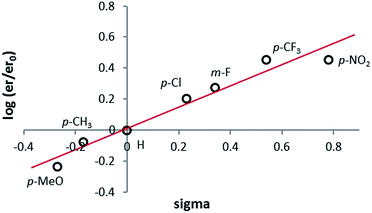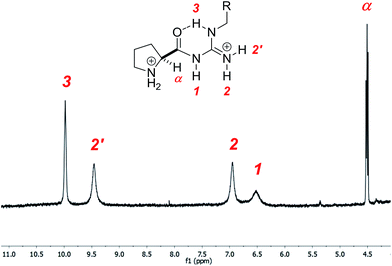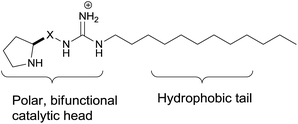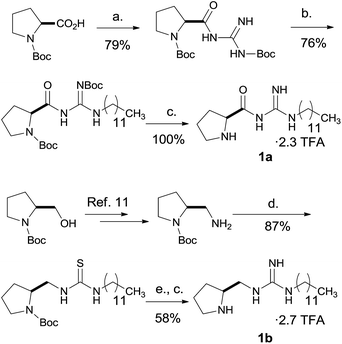Intramolecular hydrogen bonding guides a cationic amphiphilic organocatalyst to highly stereoselective aldol reactions in water†
Ángel M. Valdivielso,
Alba Catot,
Ignacio Alfonso* and
Ciril Jimeno*
Department of Biological Chemistry and Molecular Modelling, Institute of Advanced Chemistry of Catalonia (IQAC-CSIC), c/Jordi Girona 18-26, E08034 Barcelona, Spain. E-mail: ignacio.alfonso@iqac.csic.es; ciril.jimeno@iqac.csic.es
First published on 10th July 2015
Abstract
A novel amphiphilic guanidine organocatalyst, efficient for asymmetric aldol reactions of ketones in water at neutral pH, is disclosed. The reaction presented a clear substrate dependence depicting a free energy linear correlation with ee. Intramolecular hydrogen bonding in the acylguanidine moiety was identified as the key structural motif.
Asymmetric organocatalysis in water is a growing field due to the convenience of using water instead of an organic solvent and the unique physical properties imparted to the reaction system. The search for new catalysts and reactions is therefore essential for its future development. Since the successful work of Hayashi1 and Takabe and Barbas2 in the development of organocatalytic asymmetric reactions in water, excluding any organic co-solvent, several organocatalysts have been designed based on the initial concept of amphiphilic scaffolds. They feature a polar, hydrophilic catalytic moiety and a large hydrophobic group or chain.3 As a consequence, most of these types of catalysts are not water soluble but perform in emulsion, meaning that the presence of water is essential for catalysis.4,5
Within our program for the development of new catalytic entities for stereoselective synthesis,6 we became interested in the effect of water on polymer-bound organocatalysts7 and self-assembled dynamic systems,8 and turned our attention to guanidines as potential cationic self-assembled organocatalysts able to operate in water as surfactants. Guanidines offer several advantages over other functional groups since they remain protonated up to a high pH and are strong hydrogen bond donors that can bind many functional groups such as carbonyl, carboxylate, or nitro. As a result, chiral guanidines are increasingly being exploited as asymmetric catalysts in a variety of reactions.9 Therefore we based our design on the attachment of a long hydrocarbon chain to a guanidine, which in turn would be bonded to a catalytically active chiral pyrrolidine unit. The length of the alkyl chain can have a significant impact in the outcome of the reaction and the type of emulsion formed. Generally, long alkyl chains (but not too long) provide higher yields and stereoselectivities,1 and therefore a C12 alkyl chain was chosen for our catalysts (Fig. 1).
Two chiral amphiphilic guanidinium organocatalysts were synthesized following Scheme 1. Boc-proline was coupled to N-Boc-guanidine with EDC and HOBt, and subsequently subjected to substitution of an NH group by 1-dodecylamine.10 Triflic anhydride and sodium hydride under strictly anhydrous conditions were required to achieve a high yield in this reaction. Afterwards, Boc removal with TFA![[thin space (1/6-em)]](https://www.rsc.org/images/entities/char_2009.gif) :
:![[thin space (1/6-em)]](https://www.rsc.org/images/entities/char_2009.gif) CH2Cl2 was carried out, and catalyst 1a was isolated in an overall good yield as a TFA salt. On the other hand, Boc-prolinol was converted to Boc-protected 2-aminomethylpyrrolidine following a literature method,11 and afterwards transformed into the corresponding thiourea using 1-dodecylisothiocyanate.3k Guanidization of the thiourea with mercury(II) oxide and ammonia, and subsequent Boc deprotection with TFA
CH2Cl2 was carried out, and catalyst 1a was isolated in an overall good yield as a TFA salt. On the other hand, Boc-prolinol was converted to Boc-protected 2-aminomethylpyrrolidine following a literature method,11 and afterwards transformed into the corresponding thiourea using 1-dodecylisothiocyanate.3k Guanidization of the thiourea with mercury(II) oxide and ammonia, and subsequent Boc deprotection with TFA![[thin space (1/6-em)]](https://www.rsc.org/images/entities/char_2009.gif) :
:![[thin space (1/6-em)]](https://www.rsc.org/images/entities/char_2009.gif) CH2Cl2 yielded catalyst 1b as a TFA salt.
CH2Cl2 yielded catalyst 1b as a TFA salt.
Catalytic tests were then conducted using the aldol addition of cyclohexanone to benzaldehyde as a benchmark reaction. First, the aqueous phase was studied (Table 1). It was immediately evident that catalyst 1b performed poorly (entries 8 to 11), and it was discarded thereafter. Catalyst 1a showed a better level of activity, and it was also clear that the aqueous phase had a profound impact on reactivity and stereoselectivity. Hence, water and brine gave modest conversions and stereoselectivities of the aldol product (entries 1 and 2), but under buffered conditions results improved significantly. pH 7 or 6 buffer (entries 4 and 5) gave higher conversions, higher diastereomeric ratios, and an improved ee of up to 89%. In contrast, when the reaction was carried out under neat conditions, poor stereoselectivity was observed (1/4 dr and 39% ee), although the reaction was clearly faster. This last result demonstrated that the presence of water in the reaction medium was essential for stereoselectivity, rather than for rate acceleration.
| Entry | Catalysta | Aqueous phase | Conv.b [%] | syn/anti drb | eec [%] |
|---|---|---|---|---|---|
| a 0.0335 mmol of catalyst was dissolved in 3.35 mmol of cyclo-hexanone and 0.335 mmol of benzaldehyde. The appropriate aqueous phase (0.2 M Na2HPO4 to 0.1 M citric acid buffer, 0.33 ml) was added, and the mixture was stirred at rt for 48 h.b Conversion and dr determined by 1H NMR on crude mixtures.c ee of the anti diastereomer, determined by HPLC on the chiral stationary phase (chiralpak ID column, 3% IPA, 1 ml min−1). | |||||
| 1 | 1a | Water | 32 | 1/7 | 73 |
| 2 | Brine | 22 | 1/5 | 61 | |
| 3 | pH 8 buffer | 39 | 1/5 | 84 | |
| 4 | pH 7 buffer | 73 | 1/12 | 89 | |
| 5 | pH 6 buffer | 71 | 1/10 | 88 | |
| 6 | Neat | 89 | 1/4 | 39 | |
| 7 | None | pH 7 buffer | 0 | — | — |
| 8 | 1b | Water | Traces | n. d. | n. d. |
| 9 | Brine | Traces | n. d. | n. d. | |
| 10 | pH 8 buffer | 20 | 1/3 | 59 | |
| 11 | pH 7 buffer | Traces | n. d. | n. d. | |
This catalytic system formed unstable emulsions where phase separation took place steadily when stirring was stopped. Furthermore, the amount of buffer was also checked, showing that the best results were obtained when less water was present compared to organic matter (water-in-oil system, see ESI†).12 To increase the reactivity and stereoselectivity, we attempted to stabilize the structure of the putative micelles by adding an anionic (SDS) or neutral (1-dodecanol) surfactant. At 10 mol% of SDS some enhancement of enantioselectivity was observed, from 89% up to 93% ee in the benzaldehyde derived aldol, at the expense of reactivity: only 30% conversion was achieved (compare to entry 4 in Table 1). In contrast, 1-dodecanol produced no appreciable effect in the reaction but a slight decrease of enantioselectivity (see ESI†). It seems thus, that the reacting medium behaves like a dynamic emulsion where the amount of buffer and organic matter in combination with the catalyst is crucial to create the right environment for catalysis.
The substrate scope was then studied under optimized conditions (10 mol% catalyst 1a, pH 7 buffer at rt, organic/aqueous phase ratio ca. 2/1 for 48 hours) by paying attention to electronic effects from aromatic aldehydes. Good yields and stereoselectivities (both diastereo- and enantioselectivities) were achieved, and they were all clearly more pronounced for aldehydes with electron withdrawing groups (EWG, Table 2). In fact, electron donor groups slowed down the reaction, and for example, p-anisaldehyde provided a poor conversion of 13% and 80% ee (entry 3), whereas the more EWG (p-CF3 and p-NO2) provided the highest yields and ee values of up to 96% ee (entries 7 and 8). Cyclopentanone aldol derivatives could also be obtained in high yields, but surprisingly, with no diastereoselectivity and more modest ee values (entries 9 and 10). At this point, we cannot ascertain whether these results arise from a poorer catalyst performance with cyclopentanone (poor facial discrimination of the enamine intermediate) or a higher instability of the cyclopentanone derived aldols (epimerization at the α-carbon). The reaction of 2-octanone (entry 11) was slower and afforded mainly the aldol product at the terminal carbon of the ketone. Nevertheless, no byproducts were ever detected, and reactions proved to be clean, yielding only the aldol products and unreacted starting materials in all the examples studied.
| Entry | Ketone | Aldehyde | Yielda [%] | syn/anti drb | eec [%] |
|---|---|---|---|---|---|
| a Isolated yield of combined diastereomers after purification by flash chromatography.b Determined by 1H NMR on the crude product.c ee of the anti diastereomer, determined by HPLC on the chiral stationary phase.d Not isolated.e 24-hour reaction.f syn/anti/terminal dr.g ee of the terminal isomer. | |||||
| 1 | Cyclohexanone | –H | 66 | 1/12 | 89 |
| 2 | p-CH3 | 37 | 1/17 | 87 | |
| 3 | p-OMe | 13d | 1/9 | 80 | |
| 4 | o-Cl | 95 | 1/47 | 95 | |
| 5 | p-Cl | 82 | 1/28 | 93 | |
| 6 | m-F | 84 | 1/33 | 94 | |
| 7 | p-CF3 | 91e | 1/47 | 96 | |
| 8 | p-NO2 | 96e | 1/28 | 96 | |
| 9 | Cyclopentanone | p-Cl | 85 | 1/1 | 71 |
| 10 | p-NO2 | 86e | 1/1 | 87 | |
| 11 | 2-Octanone | p-NO2 | 55d,e | 1/4/11f | 75g |
Taking into account that no retro-aldol reaction or byproduct formation (for example, elimination products) was observed, we studied the enantioselectivity data in detail. We found a remarkable linear free-energy relationship on enantioselectivity with ρ = +0.68 (Fig. 2). Hammett correlations had been previously found on reaction rates for the aldol reaction of acetone with aromatic aldehydes both in the aldehyde substrates13 and the nornicotine analogues that catalyzed the reaction in water,14 but the existence of such a relationship with product enantioselectivity had remained unnoticed.15 This discovery gives a quantitative basis to the observed improvements in ee and yield when electron withdrawing groups are present in the aldehyde. Although we cannot assert that this free-energy linear relationship takes place in all organocatalyzed asymmetric direct aldol reactions in water, we do believe it is a far more general phenomenon than previously thought.
 | ||
| Fig. 2 Hammett plot for enantioselectivity-dependence on electronic effects in aromatic aldehydes in the aldol reaction of cyclohexanone in water catalyzed by 1a. ρ = +0.68. | ||
pKa differences between both guanidine groups in catalysts 1a and 1b due to the presence or absence of an adjacent carbonyl group might represent a significant factor affecting catalyst performance, with the acylguanidine catalyst 1a being clearly less basic. For example, substitution of a methyleneguanidine group for an acylguanidine group in a peptide mimic led to a pKa drop from 12.5 to 7.6.16 Accordingly, the corresponding acylguanidinium should be a better hydrogen bond donor and provide a better recognition site for catalysis. Nonetheless, we embraced a 1H NMR study of catalysts 1a and 1b to shed light on structural effects that could further rationalize in detail the improved activity found for catalyst 1a. We observed that N–H signals corresponding to the guanidine moiety were clearly distinguishable for 1a (Fig. 3), whereas broad, poorly defined signals, likely corresponding to different conformers, appeared for 1b. We attributed these differences to the higher structural rigidity of the acylguanidine group due to the presence of an intramolecular hydrogen bond between the protonated guanidinium and the carbonyl moieties. Indeed, further NMR studies pointed in the same direction. All four N–H signals of the guanidinium group in 1a could be assigned on the basis of bidimensional NMR experiments (COSY and ROESY, see ESI†). It was thus suggested that 1a presented quite a rigid structure, with the NH adjacent to the dodecyl chain forming a hydrogen bond with the carbonyl group. In fact, this signal appears as a broad triplet (but still much sharper than the other N–Hs) at lower field (9.98 ppm), which already indicates a particularly high deshielding and well-defined structure. In contrast, the equivalent proton in 1b appeared at 7.23 ppm (see ESI†).
 | ||
| Fig. 3 Expanded 1H NMR (400 MHz, 20 °C) of the guanidinium signals region of catalyst 1a, at 10 mM in CD3CN. | ||
Next, a computational study on the possible conformers of 1a was conducted at the DFT level. First, a conformational search was performed at the semi-empirical AM1 level with a catalyst analogue containing a methyl group, instead of the dodecyl chain of 1a, and two molecules of TFA. These conformational minima were then re-optimized at the B3LYP/6-31G* level in the gas phase. The four lowest energy conformers lay on a less than 2 kcal mol−1 energy gap, and all of them displayed the carbonyl-guanidinium intramolecular hydrogen bond. They were subsequently optimized using the full dodecyl chain (see ESI†). The most stable conformer by 1.06 kcal mol−1, as displayed in Fig. 4, was in full agreement with the experimental 1H NMR data.
 | ||
| Fig. 4 DFT (B3LYP/6-31G*) optimized structure for catalyst 1a·2TFA showing hydrogen bonding (dotted lines). Hydrogen, white; carbon, grey; fluorine, yellow; oxygen, red; nitrogen, blue. | ||
Other electrostatic hydrogen bonding interactions were also found computationally to take place between the catalyst and the trifluoroacetate counterions in most conformers studied: one trifluoroacetate anion is tightly bound to the guanidinium–pyrrolidinium scaffold, always in the same geometry, whereas the second one appears looser and establishes weaker interactions with the catalyst (see Fig. 4 and ESI†). Trifluoroacetate–catalyst interactions were found to be crucial to define a catalytic cavity in protonated aminobenzimidazole organocatalysts working in toluene.17 However, in the presence of water buffered at pH 7, partial protonation of the amino group and easier dissociation of the ion pairs makes it unlikely that catalyst 1a·2TFA would keep such a tight structure completely during the reaction, and the loss of one or even both trifluoroacetate anions into solution is highly probable. The persistence of the intramolecular hydrogen bond is in contrast much more likely, and since it is closer to the dodecyl chain and therefore the organic phase, it should be little affected by the aqueous environment.
Conclusions
In conclusion, we have shown that amphiphilic guanidinium cations are efficient organocatalysts for asymmetric aldol reactions in water, forming an unstable emulsion. Besides proving the high dependence of reactivity and especially stereoselectivity on the electronic nature of the aldehyde, which gives rise to a free energy linear correlation, we have also found that intramolecular hydrogen bonding in 1a provides a particular locked conformation that explains not only the structural rigidity of the catalyst as found by NMR but the efficiency in conveying asymmetry during the reaction as well. It is remarkable that this hydrogen bonding seems to remain stable during the reaction in the presence of water. This can be rationalized because the acylguanidinium hydrogen bond stays close to the dodecyl chain and therefore must remain embedded in the organic phase, rather than exposed to the aqueous phase. Therefore the success of the system is sustained by a delicate combination of intermolecular (hydrophobic) and intramolecular (H-bonds) non-covalent interactions. The understanding of the structural factors (amphiphilicity and conformational effects) governing the catalytic process will allow us a further improvement of these catalysts for intended functions, either in this or in related chemical processes.Acknowledgements
Financial support from Ministerio de Economía y Competitividad (CTQ2012-38594-C02-02 and CTQ2012-38543-C03-03) and Generalitat de Catalunya (2014 SGR 231) is gratefully acknowledged. CJ is a Ramón y Cajal fellow (RYC-2010-06750).Notes and references
- (a) Y. Hayashi, T. Sumiya, J. Takahashi, H. Gotoh, T. Urushima and M. Shoji, Angew. Chem., Int. Ed., 2006, 45, 958–961 CrossRef CAS PubMed; (b) Y. Hayashi, S. Aratake, T. Okano, J. Takahashi, T. Sumiya and M. Shoji, Angew. Chem., Int. Ed., 2006, 45, 5527–5529 CrossRef CAS PubMed; (c) S. Aratake, T. Itoh, T. Okano, N. Nagae, T. Sumiya, M. Shoji and Y. Hayashi, Chem.–Eur. J., 2007, 13, 10246–10256 CrossRef CAS PubMed.
- (a) N. Mase, Y. Nakai, N. Ohara, H. Yoda, K. Takabe, F. Tanaka and C. F. Barbas, J. Am. Chem. Soc., 2006, 128, 734–735 CrossRef CAS PubMed; (b) N. Mase, K. Watanabe, H. Yoda, K. Takabe, F. Tanaka and C. F. Barbas, J. Am. Chem. Soc., 2006, 128, 4966–4967 CrossRef CAS PubMed.
- Selected references: (a) Z. Jiang, Z. Liang, X. Wu and Y. Lu, Chem. Commun., 2006, 2801–2803 RSC; (b) G. Guillena, M. C. Hita and C. Nájera, Tetrahedron: Asymmetry, 2006, 17, 1493–1497 CrossRef CAS PubMed; (c) S. S. Chimni and D. Mahajan, Tetrahedron: Asymmetry, 2006, 17, 2108–2119 CrossRef CAS PubMed; (d) S. Aratake, T. Itoh, T. Okano, T. Usui, M. Shoji and Y. Hayashi, Chem. Commun., 2007, 2524–2526 RSC; (e) S. Guizzetti, M. Benaglia, L. Raimondi and G. Celentano, Org. Lett., 2007, 9, 1247–1250 CrossRef CAS PubMed; (f) C. Palomo, A. Landa, A. Mielgo, M. Oiarbide, A. Puente and S. Vera, Angew. Chem., Int. Ed., 2007, 46, 8431–8435 CrossRef CAS PubMed; (g) Y. Hayashi, S. Samanta, H. Gotoh and H. Ishikawa, Angew. Chem., Int. Ed., 2008, 47, 6634–6637 CrossRef CAS PubMed; (h) Y. Hayashi, T. Urushima, S. Aratake, T. Okano and K. Obi, Org. Lett., 2008, 10, 21–24 CrossRef CAS PubMed; (i) C.-M. Lo and H.-F. Chow, J. Org. Chem., 2009, 74, 5181–5191 CrossRef CAS PubMed; (j) J. Xiao, F.-X. Xu, Y.-P. Lu and T.-P. Loh, Org. Lett., 2010, 12, 1220–1223 CrossRef CAS PubMed; (k) J. Li, Y. Liu and L. Liu, Lett. Org. Chem., 2012, 9, 51–55 CrossRef CAS; (l) L. Qin, L. Zhang, Q. Jin, J. Zhang, B. Han and M. Liu, Angew. Chem., Int. Ed., 2013, 52, 7761–7765 CrossRef CAS PubMed; (m) A. Kumar and S. S. Chimni, Tetrahedron, 2013, 69, 5197–5204 CrossRef CAS PubMed; (n) Y. Qiao and A. D. Headley, Green Chem., 2013, 15, 2690–2694 RSC; (o) A. Psarra, C. G. Kokotos and P. Moutevelis-Minakakis, Tetrahedron, 2014, 70, 608–615 CrossRef CAS PubMed; (p) J. Duschmale, S. Kohrt and H. Wennemers, Chem. Commun., 2014, 50, 8109–8112 RSC; (q) F. Rodríguez-Llansola, J. F. Miravet and B. Escuder, Chem. Commun., 2009, 7303–7305 RSC; (r) C. Berdugo, J. F. Miravet and B. Escuder, Chem. Commun., 2013, 10608–10610 RSC.
- (a) J. Mlynarski and J. Paradowska, Chem. Soc. Rev., 2008, 37, 1502–1511 RSC; (b) J. Paradowska, M. Stodulski and J. Mlynarski, Angew. Chem., Int. Ed., 2009, 48, 4288–4297 CrossRef CAS PubMed; (c) J. Mlynarski and S. Bas, Chem. Soc. Rev., 2014, 43, 577–587 RSC.
- (a) A. P. Brogan, T. J. Dickerson and K. D. Janda, Angew. Chem., Int. Ed., 2006, 45, 8100–8102 CrossRef CAS PubMed; (b) Y. Hayashi, Angew. Chem., Int. Ed., 2006, 45, 8103–8104 CrossRef CAS PubMed.
- Recent examples: (a) C. Jimeno, J. Miras and J. Esq uena, ChemCatChem, 2014, 6, 2626–2633 CrossRef CAS PubMed; (b) C. Jimeno, J. Miras and J. Esq uena, Catal. Lett., 2013, 143, 616–623 CrossRef CAS.
- (a) E. Alza, X. C. Cambeiro, C. Jimeno and M. A. Pericàs, Org. Lett., 2007, 9, 3717–3720 CrossRef CAS PubMed; (b) D. Font, C. Jimeno and M. A. Pericàs, Org. Lett., 2006, 8, 4653–4655 CrossRef CAS PubMed; (c) D. Font, S. Sayalero, A. Bastero, C. Jimeno and M. A. Pericàs, Org. Lett., 2008, 10, 337–340 CrossRef CAS PubMed.
- (a) J. Atcher and I. Alfonso, RSC Adv., 2013, 3, 25605–25608 RSC; (b) J. Atcher, A. Moure and I. Alfonso, Chem. Commun., 2013, 487–489 RSC; (c) J. Solà, M. Lafuente, J. Atcher and I. Alfonso, Chem. Commun., 2014, 4564–4566 RSC; (d) J. Atcher, A. Moure, J. Bujons and I. Alfonso, Chem.–Eur. J., 2015, 21, 6869–6878 CrossRef CAS PubMed.
- Selected references: (a) C. Uyeda and E. N. Jacobsen, J. Am. Chem. Soc., 2011, 133, 5062–5075 CrossRef CAS PubMed; (b) C. Uyeda and E. N. Jacobsen, J. Am. Chem. Soc., 2008, 130, 9228–9229 CrossRef CAS PubMed; (c) C. Uyeda, A. R. Roetheli and E. N. Jacobsen, Angew. Chem., Int. Ed., 2010, 49, 9753–9756 CrossRef CAS PubMed; (d) Y. Kobayashi, Y. Taniguchi, N. Hayama, T. Inokuma and Y. Takemoto, Angew. Chem., Int. Ed., 2013, 52, 11114–11118 CrossRef CAS PubMed; (e) Y. Sohtome, B. Shin, N. Horitsugi, K. Noguchi and K. Nagasawa, Chem.–Asian J., 2011, 6, 2463–2470 CrossRef CAS PubMed; (f) Y. Sohtome, N. Takemura, K. Takada, R. Takagi, T. Iguchi and K. Nagasawa, Chem.–Asian J., 2007, 2, 1150–1160 CrossRef CAS PubMed; (g) K. Takada and K. Nagasawa, Adv. Synth. Catal., 2009, 351, 345–347 CrossRef CAS PubMed; (h) L.-J. Wang and F.-F. Flu, Bull. Korean Chem. Soc., 2010, 31, 1280–1282 CrossRef CAS; (i) M. Orlandi, M. Benaglia, L. Raimondi and G. Celentano, Eur. J. Org. Chem., 2013, 2346–2354 CrossRef CAS PubMed; (j) E. Riguet, Tetrahedron Lett., 2009, 50, 4283–4285 CrossRef CAS PubMed.
- C. Schmuck, T. Rehm, F. Grohn, K. Klein and F. Reinhold, J. Am. Chem. Soc., 2006, 128, 1430–1431 CrossRef CAS PubMed.
- N. Dahlin, A. Bogevig and H. Adolfsson, Adv. Synth. Catal., 2004, 346, 1101–1105 CrossRef CAS PubMed.
- L. Zhong, Q. Gao, J. Gao, J. Xiao and C. Li, J. Catal., 2007, 250, 360–364 CrossRef CAS PubMed.
- D. Tichit, M. H. Lhouty, A. Guida, B. H. Chiche, F. Figueras, A. Auroux, D. Bartalini and E. Garrone, J. Catal., 1995, 151, 50–59 CrossRef CAS.
- C. J. Rogers, T. J. Dickerson, A. P. Brogan and K. D. Janda, J. Org. Chem., 2005, 70, 3705–3708 CrossRef CAS PubMed.
- ee was measured before or just after reaction completion. Aldol products epimerize slowly if kept in chloroform solution at rt.
- A. E. P. Adang, H. Lucas, A. P. A. de Man, R. A. Engh and P. D. J. Grootenhuis, Bioorg. Med. Chem. Lett., 1998, 8, 3603–3608 CrossRef CAS.
- (a) E. Gómez-Torres, D. A. Alonso, E. Gómez-Bengoa and C. Nájera, Org. Lett., 2011, 13, 6106–6109 CrossRef PubMed; (b) E. Gómez-Torres, D. A. Alonso, E. Gómez-Bengoa and C. Nájera, Eur. J. Org. Chem., 2013, 1434–1440 CrossRef PubMed.
Footnote |
| † Electronic supplementary information (ESI) available: Experimental procedures, compounds characterization spectra, and HPLC traces. See DOI: 10.1039/c5ra12135c |
| This journal is © The Royal Society of Chemistry 2015 |




